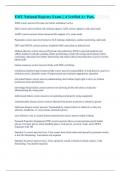EMT National Registry Exam || A Verified A+ Pass.
EMR correct answers Provide care before ambulance arrive
EMT correct answers Basic life training support, AED, airway adjuncts, and some meds
AEMT correct answers Some advanced life support, IVs, some meds.
Paramedic correct answers Extensive ALS training, intubation, cardiac monitoring, and meds.
DOT and NHTSA correct answers Establish EMS curriculum at federal level
Medical director correct answers Physician who authorizes EMTs to provide medical care;
offline (indirect) includes standing orders (performing certain life-saving interventions before
contacting a physician for further instruction) and online (direct) med direction is given over the
phone/radio
human resources correct answers Deals with EMS well being
Continuous Quality Improvement (CQI) correct answers responsibility of med director, goal is to
minimize errors, identifies areas of improvement and continues appropriate education
rule-based failure correct answers administering med without legal right to do so or without
permission from med director
knowledge-based failure correct answers not knowing all the info about a medicine-
administering the wrong med
skills-based failure correct answers not operating and properly using equipment.
communicable disease correct answers Spread from person to person or animal to person
infectious disease correct answers Transmitted by contact (direct or indirect), or they are
airborne, foodborne, or vector-borne (animals/insects)
most effective way to control disease transmission correct answers hand washing
Personal Protective Equipment (PPE) correct answers Gloves (wear puncture-proof leather
gloves over latex gloves when handling glass). And gowns, eyewear, mask, and a HEPA
respirator with TB.
Hepatitis A correct answers liver; Virus comes from fecal matter and spread by personal contact,
is not life threatening. Vaccination not required
Hepatitis B correct answers liver; Virus spread by sexual or blood-to-blood contact, is life
threatening. Vaccination required.
,general adaption syndrome correct answers Body's response to stress. Alarm response ->reaction
and resistance -> recovery or exhaustion.
acute stress reactions correct answers Occur during stressful reactions.
delayed stress reactions correct answers occur after stressful reactions
cumulative stress reactions correct answers prolonged/extensive stress
stress symptoms correct answers -Increased resp/heart rate
-Tense muscles
-Dilated vessels-cool clammy skin
-Dilated pupils
-Perspiration
-Increased BP
Posttraumatic Stress Disorder (PTSD) correct answers Re-experiencing the event and over
responding to stimuli that recall the event
defusing sessions correct answers during/immediately after the event
Debreifing session correct answers occur within 24-72 hours of incident; workers express
emotion and relieve stress
quid pro quo correct answers request for sexual favors
hostile work enviroment correct answers jokes/touching/etc
stages of grieving correct answers 1)Denial
2)Anger/Hostility- projection of bad news into environment
3)Bargaining- secure prize for good behavior (ex: be nice if I love until X date)
4)Depression- Internalized anger, hopelessness
5)Acceptance
five hazards most commonly associated with a structural fire correct answers smoke, oxygen
deficiency, high ambient temperatures, toxic gases, and building collapse
expressed consent correct answers patient verbally accepts care
implied concent correct answers For patients who are unconscious (drugs, alcohol, head injury,
etc.) or unable to make a rational informed decision, and for kids with no parent present.
informed consent (all consent must be this!) correct answers Patient must be told of all risks,
benefits, and alternative treatments
,emancipated minors correct answers Under 18 that can legally give consent because they're
considered adults. Married, in the army, have a child, or independent of parents.
scope of practice correct answers Outlines the care you are able to provide for the patient;
defined by state law.
standard of care correct answers Manner in which an EMT must act
determination of negligence correct answers based on four factors: duty, breach of duty,
damages, and causation
abandonment correct answers Termination of care without the patient's consent and without the
transfer of care to a medical professional with skills at the same level or at a higher level than
your own
assault correct answers Unlawfully placing a person in fear of bodily harm (restraint)
battery correct answers Unlawfully touching a person (providing care without consent)
defamation correct answers Presenting false information that can damage a person's reputation.
(libel: in writing; slander: verbal)
behavioral crisis correct answers Spend more time with these patients, stay calm, contact law
enforcement
definitive signs of death correct answers -Decapitation
-Dependent Lividity- blood settles to lowest part of body
-Rigor Mortis- muscle stiffness
-Putrefaction- decomposition of body tissue
good samaritan law correct answers protects you if you act within scope of training and not in a
grossly negligent manner
refusal of care correct answers Have patient sign a refusal form and also have family member,
police officer, or bystander also sign as witness
Patient care report (PCR) correct answers 1) Continuity of Care
2) Legal Documentation
3) Education
4) Administrative Info
5) Research Record
6) Evaluation & CQI
base station correct answers radio containing a transmitter and receiver located in a fixed
location.
, mobile radio correct answers Vehicle device that operates at lower frequency than a base station
portable radio correct answers Handheld device, 1-5-watt operation
repeater correct answers Base station radio that receives messages & signals on one frequency
then retransmits them on a higher 2nd frequency
telemetry correct answers Electronic signals are converted into coded, audible sounds
Federal Communications Commission (FCC) correct answers regulates all radio operations in
the US
planes of body correct answers -Coronal- front/back
-Transverse- top/bottom
-Sagittal (lateral)- left/right
anterior/ventral correct answers front of the body
posterior/dorsal correct answers back of body
superior correct answers toward the head
inferior correct answers toward the feet
proximal correct answers closer to the trunk of the body
distal correct answers Farther from the trunk of the body
medial correct answers Toward the midline of the body
lateral correct answers away from the midline
flexion correct answers bending a joint
extention correct answers Straightening a body part
adduction correct answers movement toward the midline
abduction correct answers movement away from the midline
Four parts of abdomen correct answers RUQ, LUQ, RLQ, LLQ
RUQ correct answers Liver, kidney, gallbladder, colon, pancreas
LUQ correct answers stomach, kidney, spleen, colon, pancreas




